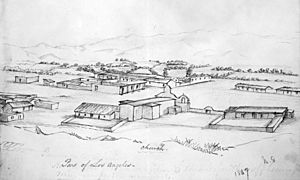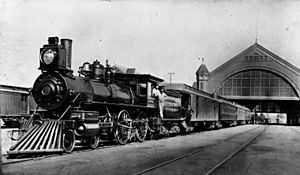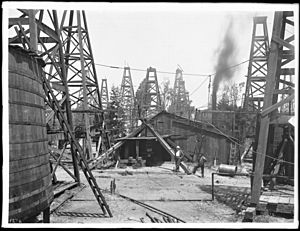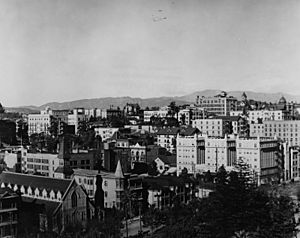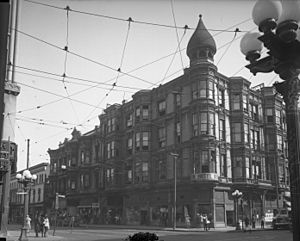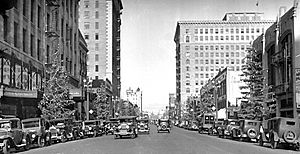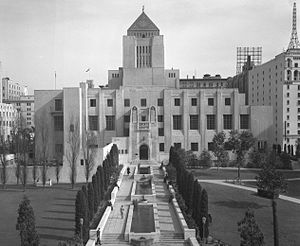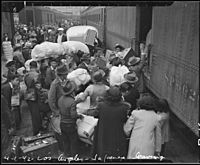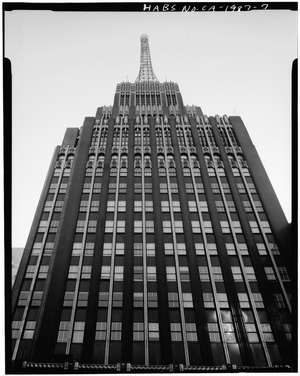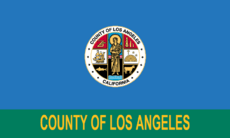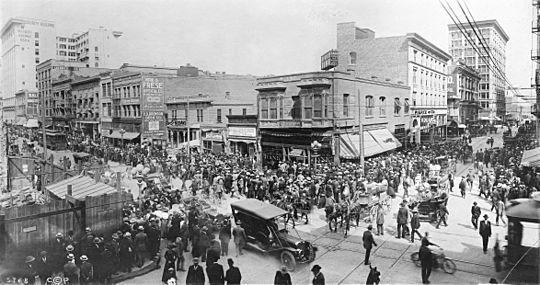History of Los Angeles facts for kids
The history of Los Angeles started in 1781. At that time, 44 settlers from New Spain created a new town in what is now Downtown Los Angeles. This was ordered by the Spanish Governor, Felipe de Neve. After 1848, when control changed from Mexico to the United States, big changes happened. The Santa Fe railroad line from Chicago reached Los Angeles in 1885. Many people, mostly white Protestants, moved to the city.
Los Angeles had a strong economy based on farming, oil, tourism, real estate, and movies. It grew quickly, with many new neighborhoods. Its movie industry made the city famous worldwide. World War II brought new industries, especially building high-tech airplanes.
Since the 1960s, growth has slowed down. Traffic jams have become very common. Los Angeles was one of the first cities to build many freeways as its public transportation got worse. Many new people, especially from Mexico and Asia, have moved to the city since the 1960s. Older industries like farming, oil, and aircraft manufacturing have become smaller. But tourism, entertainment, and high-tech industries are still very strong. Over time, droughts and wildfires have happened more often. They now occur year-round, making it harder for the city to get enough water.
Contents
Early History of Los Angeles
Around 3000 B.C., people who spoke the Hokan language lived in the Los Angeles area. They fished, hunted sea animals, and gathered wild seeds. Later, new groups of people arrived, possibly because of droughts. They spoke a language called Tongva. The Tongva people called the Los Angeles region Yaa.
When the Spanish arrived in the 1700s, there were about 5,000 native people in the Los Angeles basin. After meeting Europeans, these people became known as Gabrielinos and Fernandeños. These names came from the missions they were linked to.
The Gabrielinos lived on about four thousand square miles of land. This included the large area around the Los Angeles and San Gabriel rivers. It also included the southern Channel Islands. They were part of a large trading network with other groups. These included the Chumash to the west and the Cahuilla to the east.
The Gabrielinos had their own religious and cultural beliefs. They worshipped a creator god, Chinigchinix, and a female god, Chukit. They believed in an afterlife. Their language was called Kizh or Kij, and they practiced cremation.
Long before the Europeans came, the Gabrielinos had found the best places to live. The success of Los Angeles would depend a lot on a nearby Gabrielino village called Yaanga. The people of Yaanga provided the colonists with seafood, fish, bowls, and baskets. They also helped by digging ditches and carrying water. Many of them married Mexican colonists.
Spanish Era: 1769–1821
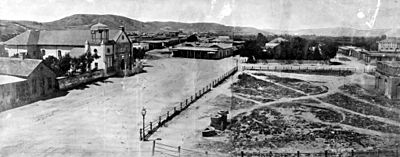
The first Europeans to visit the area were Captain Juan Rodríguez Cabrillo in 1542 and Captain Sebastián Vizcaíno in 1602. It would be 166 years before another European visited the region.
Planning the Town
The person most important for starting Los Angeles was the new Governor of California, Felipe de Neve.
In 1777, Neve traveled through Alta California. He decided to create towns to support the military forts. These new towns would help the military rely less on the missions. They would also help farming and other industries grow.
Neve chose Santa Barbara, San Jose, and Los Angeles for his new towns. His plans followed Spanish city-planning laws from 1573, called the Laws of the Indies. These laws helped create many large cities in the region, including Los Angeles.
The Spanish plan included a central open plaza. Around it would be a church, government buildings, and streets laid out in a grid. This grid defined rectangular plots of land for farming and homes.
Following these plans, Governor Neve founded the town of San Jose de Guadalupe on November 29, 1777. This was California's first official town.
The First Settlers
The Los Angeles Pobladores are the 44 original settlers of Los Angeles. There were 22 adults and 22 children from Sonora, Mexico.
In December 1777, Viceroy Antonio María de Bucareli approved the founding of a town at Los Angeles. He also approved a new fort at Santa Barbara. An officer named Fernando Rivera y Moncada was in charge of finding settlers. He was supposed to find 55 soldiers and 22 settlers with families. After a long search, he found only 12 settlers and 45 soldiers. Like most people in New Spain, they were a mix of Indian and Spanish backgrounds.
The settlers arrived in two groups in 1781. Some likely started working on their land plots in early summer.
Founding the City
The official founding date for Los Angeles is September 4, 1781.
The first name given to the settlement is still debated. Some historians say it was "El Pueblo de la Reyna de los Angeles" ("The Town of the Queen of the Angels"). Others say it was "El Pueblo de Nuestra Señora de los Angeles de Porciuncula" ("the town of Our Lady of the Angels of Porciuncula").
Early Town Life
The town grew as more soldiers and settlers arrived. In 1784, a chapel was built on the Plaza. The original settlers received official ownership of their land two years later. By 1800, there were 29 buildings around the Plaza. These were one-story adobe buildings with thatched roofs. By 1821, Los Angeles had become a successful farming community. It was the largest in Southern California.
Each settler received four plots of land for farming. Two plots were irrigated, and two were dry. When the settlers arrived, the Los Angeles floodplain had many willows and oaks. The Los Angeles River flowed all year. There was a lot of wildlife, including deer, antelope, and even grizzly bears. There were also many wetlands and swamps.
The first settlers built a water system with ditches from the river. These ditches ran through the town and to the farmlands. Native Americans were hired to carry fresh drinking water from a special pool upstream. The city first became known for producing good wine grapes. Raising cattle and trading animal fat and hides came later.
The demand for Native American labor grew quickly. The village of Yaanga started attracting Native Americans from other areas. Unlike the missions, the settlers paid Native Americans for their work. They worked as farm workers, cowboys, and domestic helpers. They were paid with clothing, goods, cash, and alcohol. This trade helped the town's economy grow and attracted more Native Americans.
In the 1780s, the San Gabriel Mission faced a Native American revolt. The mission had taken all the good farming land. Native Americans felt abused and forced to work on lands they once owned. A young Native American healer named Toypurina led an attack on the mission. The soldiers defended the mission and arrested 17 people, including Toypurina.
In 1787, Governor Pedro Fages created rules for employing Native Americans. These rules said not to use physical punishment and to protect Native American villages. This gave Native Americans more freedom to choose between the missions and the town-related villages.
In 1795, Sergeant Pablo Cota led an expedition. He observed that Native Americans preferred working in Los Angeles. They worked as cowboys and cared for crops. Many Native Americans were drawn to the town not just for work but also through marriage. In 1784, the first recorded marriages in Los Angeles happened. Two sons of a settler married two young Native American women.
Construction on the Plaza's church, La Iglesia de Nuestra Señora de Los Ángeles, took place from 1818 to 1822. Much of the work was done by Native American laborers. This new church completed the shift of power from the mission to the town. The people of Los Angeles no longer had to travel 11 miles to Sunday Mass at Mission San Gabriel.
Mexican Era: 1821–1848
Mexico became independent from Spain in 1821. This was celebrated with great joy in Alta California. People were no longer subjects of a king; they were now citizens with rights. In towns like Los Angeles, people promised loyalty to the new government. The Spanish flag was lowered, and the flag of independent Mexico was raised.
Independence brought economic growth. The population also grew as more Native Americans joined the Mexican culture. More people arrived from America, Europe, and other parts of Mexico. Before 1820, Los Angeles had only 650 people. By 1841, the population nearly tripled to 1,680.
Changes to Missions
During the 1820s, farming and cattle ranching grew. Trade in hides and animal fat also increased. The new church was finished, and the city's political life developed. Los Angeles was separated from Santa Barbara's control. The water ditch system was rebuilt. Trade increased even more when the Mexican government took control of the California missions in 1833. Large mission lands suddenly became available to government officials, ranchers, and land buyers. The governor gave out over 800 land grants during this time. This included a grant of over 33,000 acres in 1839 that later became the west side of Los Angeles.
However, much of this progress did not help the Native Americans. They were seen as minors who could not make their own decisions. They lost their land, often by getting into debt.
In 1834, Governor Pico was married in the Plaza church. The entire town of 800 people attended. In 1835, the Mexican Congress declared Los Angeles a city. It became the official capital of Alta California. It was now the region's most important city.
Many foreigners from the United States and Europe also arrived. They would play a key role when the U.S. took over. Early California settler John Bidwell remembered people he knew in 1845, including Governor Pío Pico and others.
In 1831, Jean-Louis Vignes bought 104 acres of land near the Los Angeles River. He planted a vineyard to make wine. He named his property El Aliso. The grapes available then were the Mission variety. Vignes was not happy with them, so he imported better grapes from Bordeaux. In 1840, he made the first recorded shipment of California wine. By 1849, El Aliso was the largest vineyard in California. Vignes had over 40,000 grapevines and produced a lot of wine each year.
Mexican-American War
In May 1846, the Mexican–American War began. Mexico could not defend its northern lands, so California was open to invasion. On August 13, 1846, Commodore Robert F. Stockton and John C. Frémont took control of Los Angeles. Governor Pico had fled to Mexico. After three weeks, Stockton left, leaving Lieutenant Archibald H. Gillespie in charge. Gillespie's harsh treatment caused 300 local people to force the Americans to leave. This ended the first part of the Siege of Los Angeles.
More small fights happened. Stockton gathered his troops in San Diego and marched north. Frémont marched south from Monterey. After a few small battles outside the city, the two forces entered Los Angeles peacefully. Andrés Pico was in charge. He signed the Treaty of Cahuenga on January 13, 1847. This ended the war in California. The Treaty of Guadalupe Hidalgo, signed on February 2, 1848, officially ended the war and gave California to the U.S.
Transition Era: 1848–1870
After the U.S. took over, land laws changed. Under Spanish law, land could not be sold easily. Under U.S. law, city-owned lands could be sold. Also, the old Spanish property sketches did not guarantee ownership in American courts.
California's new military governor, Bennett C. Riley, said land could not be sold if it wasn't on a city map. In 1849, Lieutenant Edward Ord surveyed Los Angeles. His survey confirmed and extended the city's streets. This started the city's first real estate boom and filled its treasury. Street names were changed from Spanish to English. New surveys and street plans replaced the original town layout. A new city center was planned south of the Plaza.
The city's real estate began to divide along Anglo-Mexican lines. In the Spanish system, the powerful people lived around the Plaza. In the new American system, they moved to the outskirts. Minority groups, including Chinese, Italians, French, and Russians, joined the Mexicans near the Plaza.
In 1848, gold was discovered in Coloma. Thousands of miners from northern Mexico came through Los Angeles on their way to the gold fields. So many settled north of the Plaza that the area became known as Sonoratown.
During the Gold Rush, Los Angeles became known as the "Queen of the Cow Counties." It supplied beef and other food to the hungry miners in the north. Los Angeles County had the largest cattle herds in California.
With no strong legal system, the city quickly became lawless.
Some residents fought against the new Anglo powers by becoming bandits. In 1856, Juan Flores threatened Southern California with a revolt. He was hanged in Los Angeles. Tiburcio Vasquez, a famous bandit, was captured in 1874 and hanged in 1875.
The fear of Mexican violence and the violence against Mexicans pushed them to the side. This greatly reduced their chances for economic and political success.
John G. Downey, the seventh Governor of California, took office on January 14, 1860. He was the first Governor from Southern California. Governor Downey was born in Ireland and came to Los Angeles in 1850. He helped keep California in the Union during the Civil War.
Native American Challenges
In 1836, the Native American village of Yaanga was moved. In 1845, it was moved again. When the Americans arrived, diseases greatly affected Native Americans. Between 1848 and 1880, the Native American population in Los Angeles dropped sharply. Self-employed Native Americans were not allowed to sleep in the city. They faced more competition for jobs as more Mexicans moved into the area. Those who were unemployed were arrested and auctioned off as workers to those who paid their fines. They were often paid with alcohol, which made their problems worse.
Los Angeles became an American city on April 4, 1850. Five months later, California joined the United States. The treaty that ended the Mexican-American War said the U.S. should give citizenship to Native Americans in former Mexican lands. However, the U.S. did not do this for another 80 years. California's Constitution did not protect Native Americans under the law. This made it impossible to try an Anglo for harming a Native American or taking their property.
When author Helen Hunt Jackson visited Native American villages in Southern California in 1883, she was shocked by the racism. She wrote that Anglos treated Native Americans worse than animals. They hunted them for fun, stole their farmlands, and pushed them close to extinction. While whites often said Native Americans were lazy, Jackson found most of them to be hard-working. Jackson's visit inspired her 1884 novel, Ramona. She hoped it would show the human side of the terrible things Native Americans suffered. The novel was very successful. Many Native American villages in Southern California survived because of her efforts.
The Gabrielino Native Americans, now called Tongva, also survived. In 2006, the Los Angeles Times reported that 2,000 of them still lived in Southern California. Some were working to protect their burial and cultural sites. Others were trying to get federal recognition as a tribe. The city's first newspaper, Star of Los Angeles, started in 1851 and was printed in two languages.
Industrial Growth: 1870–1913
In the 1870s, Los Angeles was still a small village of 5,000 people. By 1900, over 100,000 people lived in the city. Several men actively worked to make Los Angeles a great city and become rich. People in Los Angeles wanted to compete with San Francisco, which had good port facilities, railways, banks, and factories. The Farmers and Merchants Bank of Los Angeles was the first official bank in Los Angeles. It was founded in 1871 by John G. Downey and Isaias W. Hellman. Rich people from the East who visited as tourists saw the chances for growth and invested a lot of money in the area.
Much of Los Angeles County was farmland. Farmers focused on cattle, dairy products, vegetables, and citrus fruits. After 1945, most of this farmland was turned into housing developments.
Railroads Arrive
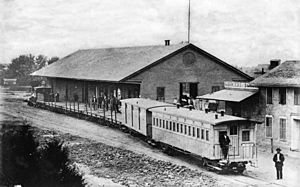
The city's first railroad, the Los Angeles & San Pedro Railroad, opened in October 1869. It was started by John G. Downey and Phineas Banning. It ran 21 miles between San Pedro and Los Angeles.
The town continued to grow steadily. Railroads finally connected Los Angeles with the Central Pacific and San Francisco in 1876. The biggest impact came from the Santa Fe system in 1885. The Santa Fe and Southern Pacific lines offered direct connections to the East. They competed fiercely with lower prices, which helped the economy grow. Thousands of tourists came every week, and many planned to return or move there.
The city still needed a modern harbor. Phineas Banning dug a channel from the mud flats of San Pedro Bay to Wilmington in 1871. Banning had already built tracks and brought in trains to connect the port to the city. Harrison Gray Otis, owner of the Los Angeles Times, and other business partners worked to expand this into a harbor at San Pedro using government money.
This put them against Collis Potter Huntington, president of the Southern Pacific Railroad Company. The Southern Pacific line reached Los Angeles in 1876. Huntington wanted the main port to be at Santa Monica, where the Long Wharf was built.
In April 1872, John G. Downey successfully represented Los Angeles in talks with Collis Huntington. They discussed bringing the Southern Pacific Railroad through Los Angeles.
In 1876, the Newhall railroad tunnel was finished. It was 27 miles north of Los Angeles. This tunnel provided the final link for the railroad from San Francisco to Los Angeles. The 6,940-foot-long tunnel took a year and a half to build. Over 1,500 mostly Chinese workers built the tunnel. Many had worked on other tunnels for the Southern Pacific. The ground was soft and wet with oil, causing frequent cave-ins. Workers had to constantly support the tunnel with timbers. The first train passed through on August 12, 1876. On September 4, Charles Crocker announced that the track between San Francisco and Los Angeles was complete.
The San Pedro supporters eventually won. Work on the San Pedro breakwater began in 1899 and finished in 1910. Otis Chandler and his friends changed state law in 1909. This allowed Los Angeles to take over San Pedro and Wilmington. They used a long, narrow strip of land to connect them to the rest of the city. This fight over the harbor was called the Free Harbor Fight.
In 1898, Henry E. Huntington and a group from San Francisco bought five trolley lines. They combined them into the Los Angeles Railway (the 'yellow cars'). Two years later, they started the Pacific Electric Railway (the 'red cars'). The Los Angeles Railway served the city, and the Pacific Electric Railway served the rest of the county. At its peak, the Pacific Electric was the largest electric interurban railway in the world. Over 1,000 miles of tracks connected Los Angeles with many other towns. It was known as the best public transportation system in the world.
Oil Discovered
Oil was found by Edward L. Doheny in 1892, near where Dodger Stadium is today. The Los Angeles City Oil Field was the first of many oil fields in the area. In 1900 and 1902, the Beverly Hills Oil Field and Salt Lake Oil Field were found nearby. Los Angeles became a major oil production center in the early 1900s. By 1923, the region produced one-quarter of the world's oil supply. It is still a significant producer today.
Workers' Rights and Conflicts
Immigrants coming to the city for jobs sometimes brought strong ideas from their home countries. These included activists like Emma Goldman and Ricardo Flores Magón. They were later joined by socialist candidates and labor organizers. Socialists were the first to speak freely in the Plaza. This area became a place for union rallies and protests. Police often tried to break up these meetings.
The L.A. Times wanted Los Angeles to be a city without labor unions. Fruit growers and local businesses formed the Merchants and Manufacturers Association (M & M) to support the L.A. Times' anti-union efforts.
The California labor movement, strong in San Francisco, had mostly ignored Los Angeles. But in 1907, the American Federation of Labor decided to challenge the anti-union policies in Los Angeles.
In 1909, the city leaders banned free speech on public streets, except for the Plaza. Locals said the Plaza had always been an open forum. The owners of the L.A. Times were especially concerned about this area.
This conflict became very serious with the Los Angeles Times bombing in 1910. Two months later, another building was bombed. The authorities accused John and James McNamara, who were linked to the Iron Workers Union, of the bombing. Clarence Darrow, a famous defense lawyer, represented them.
While the McNamara brothers awaited trial, Los Angeles was preparing for a city election. Job Harriman, a socialist candidate, was running against the establishment's candidate.
Harriman's campaign was tied to the idea that the McNamaras were innocent. But the defense had problems. The prosecution had evidence of the McNamaras' guilt. On December 1, 1911, four days before the election, the McNamaras pleaded guilty in exchange for prison terms. Harriman lost the election badly.
On Christmas Day, 1913, police tried to break up a large rally in the Plaza. They attacked the crowd with clubs, and one person was killed. In response, the authorities tried to impose martial law. Seventy-three people were arrested. The City Council introduced new rules to control public speaking.
The anti-union campaign continued strongly. By 1923, the Industrial Workers of the World had made progress organizing dockworkers in San Pedro. About 3,000 men went on strike. With the support of the L.A. Times, a special "Red Squad" was formed within the Los Angeles Police Department. They arrested so many strikers that the city's jails were full.
About 1,200 dock workers were held in a special camp in Griffith Park. The L.A. Times approved, saying that "forced labor was a good remedy." Public meetings were banned in San Pedro. Upton Sinclair was arrested for reading the United States Bill of Rights on private property. The strike ended after members of the Ku Klux Klan and the American Legion attacked the union hall. The strike was defeated.
Los Angeles gained another industry in the early 1900s when movie producers moved there from the East Coast. These new employers also feared unions. During Upton Sinclair's campaign for Governor of California, Louis B. Mayer of MGM used his studio to fight against Sinclair. MGM produced fake newsreels to make Sinclair look bad. Sinclair lost the election.
Los Angeles also gained the garment industry before World War II. It started with sportswear and grew to be the second largest center for clothing production in the United States.
Unions began to organize these workers in the 1930s with the New Deal. A key event was the Los Angeles Garment Workers strike of 1933. Mexican immigrant workers played a big role in this strike for union recognition. Unions made even greater gains during the war years as Los Angeles grew.
Today, Los Angeles is a strong union town. However, many garment workers, mostly Mexican immigrants, still work in difficult conditions.
Controlling the Los Angeles River
The Los Angeles River used to flow clearly all year. It supported 45 Native American villages. The river's water came from underground water in the San Fernando Valley, fed by mountain snow. Early settlers were often frustrated by the unpredictable weather. Long droughts killed their livestock, and then fierce storms caused floods. During dry years, people built too close to the riverbed. Their homes and barns were later swept away during floods. The Los Angeles Plaza had to be moved twice because it was built too close to the river.
Floods would also change the river's path. When settlers arrived, the river flowed into Santa Monica Bay. A strong storm in 1835 changed its course to Long Beach, where it flows today.
Early citizens could not even keep a footbridge over the river. After the American takeover, the city council spent $20,000 on a wooden bridge. The first storm that came along destroyed the bridge.
Some of the heaviest rainfall in U.S. history has happened in the San Gabriel Mountains north of Los Angeles. In January 1969, more water fell on the San Gabriels in nine days than New York City gets in a year. This caused huge mudslides.
Arguments between city and county governments delayed action on flooding. Then, a massive storm in 1938 flooded Los Angeles and Orange Counties. The federal government stepped in. To move floodwater to the sea quickly, the Army Corps of Engineers paved the riverbed and its smaller streams. They also built dams and basins in the canyons to reduce mudslides. This was a huge project that took years to finish.
Today, the Los Angeles River mainly controls floods. A raindrop falling in the San Gabriel Mountains can reach the sea faster than a car can drive. During rainstorms, the Los Angeles River at Long Beach can have as much water as the Mississippi River at St. Louis.
Drilling wells and pumping water from the San Fernando Valley dried up the river by the 1920s. By 1980, the underground water supplied drinking water for 800,000 people. That year, it was found that the water was contaminated, and many wells were shut down.
Bringing Water from Far Away
For its first 120 years, the Los Angeles River provided enough water for homes and farms. It was thought the river could support a town of 250,000 people if managed well. But people in Los Angeles used a lot of water. They constantly watered their lawns, gardens, and farms. Later, they needed more water for businesses and factories. By the early 1900s, the town realized it would soon outgrow its river and need new water sources.
Concerns about water supply were used to get support for a huge project to bring more water to the city. This would allow more development. The city leaders wanted water from the Owens River, about 250 miles northeast of Los Angeles. It was a constant stream of fresh water from the melted snow of the eastern Sierra Nevada.
Between 1899 and 1903, Harrison Gray Otis and his son-in-law, Harry Chandler, bought cheap land on the northern edge of Los Angeles in the San Fernando Valley. At the same time, they got help from William Mulholland, chief engineer of the Los Angeles Water Department.
Mulholland's assistant, J.B. Lippencott, secretly worked for Los Angeles while doing water surveys in the Owens Valley for the government. He convinced Owens Valley farmers to give up their water rights to 200,000 acres of land to Frederick Eaton, a former mayor of Los Angeles. Lippencott then left his government job and gave all his survey maps to the city. These studies were used to design the longest aqueduct in the world.
By July 1905, the Times warned Los Angeles voters that the county would dry up unless they approved money for the aqueduct. Fake drought conditions were created by running water into sewers. Residents were forbidden to water their lawns.
On election day, the people of Los Angeles voted to spend $22.5 million to build the aqueduct from the Owens River. With this money, and a special law from Congress, the city bought the land Eaton had acquired. On November 5, 1913, when the Los Angeles Aqueduct opened, Mulholland's entire speech was five words: "There it is. Take it."
Boom Town: 1913–1941
Hollywood's Rise
Hollywood has been famous worldwide for the film industry for over a hundred years. It became the City of Hollywood in 1903 but joined Los Angeles in 1910. In the 1900s, Jewish movie makers from New York found the sunny weather better for filming all year. It grew into the center of the U.S. film industry. Many famous actors, directors, and singers have lived and worked there. This led to the growth of related television and music industries.
Key Events
Swimming Pool Integration In 1931, a judge ordered an end to racial segregation in city swimming pools. This happened after Ethel Prioleau, a Black woman, sued the city. She complained she was not allowed to use the pool in Exposition Park and had to travel far to a designated "negro swimming pool."
Summer Olympics Los Angeles hosted the 1932 Summer Olympics. The Los Angeles Memorial Coliseum, which opened in 1923, was made larger for the Olympic events. It is still used by the USC Trojans football team. Olympic Boulevard, a major road, is named after this event.
Griffith Park Fire A terrible brush fire on October 3, 1933, killed 29 workers and injured 150 others. They were clearing brush in Griffith Park.
City Expansion
The City of Los Angeles mostly stayed within its original 28 square miles until the 1890s. The original city limits can still be seen in how the streets are laid out. The first large areas added to the city were Highland Park and Garvanza to the north, and the South Los Angeles area. In 1906, the Port of Los Angeles was approved. A change in state law allowed the city to add the Shoestring, a narrow strip of land connecting Los Angeles to the port. The port cities of San Pedro and Wilmington were added in 1909. The city of Hollywood was added in 1910, making the city 90 square miles.
The opening of the Los Angeles Aqueduct gave the city four times more water than it needed. Offering water service became a strong way to attract nearby communities. The city, with a large debt and extra water, gained customers by adding them to the city. Harry Chandler, a big investor in San Fernando Valley real estate, used his Los Angeles Times to promote development near the aqueduct's end. By a vote of the residents, 170 square miles of the San Fernando Valley were added to the city in 1915. This almost tripled the city's area. Over the next seventeen years, many more areas were added. By 1932, the city's area was 450 square miles.
Most of the added communities were unincorporated towns. But ten incorporated cities joined Los Angeles: Wilmington (1909), San Pedro (1909), Hollywood (1910), Sawtelle (1922), Hyde Park (1923), Eagle Rock (1923), Venice (1925), Watts (1926), Barnes City (1927), and Tujunga (1932).
LAX: Los Angeles International Airport
Mines Field opened as a private airport in 1930. The city bought it to be the main airport in 1937. It became Los Angeles Airport in 1941 and Los Angeles International Airport (LAX) in 1949. In the 1930s, the main airline airports were Burbank Airport and Grand Central Airport in Glendale. In late 1946, most airline flights moved to LAX. Since then, LAX has grown continuously, leading to more hotels and warehouses nearby.
World War II: 1941–1945
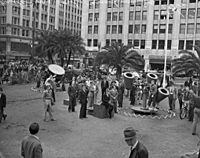
During World War II, Los Angeles grew as a center for making aircraft, war supplies, and ammunition. Thousands of people, both Black and white, moved to the West from the South and the Midwest to fill factory jobs.
After President Franklin D. Roosevelt issued an order, military leaders could remove people from certain areas for national defense. This led to many Japanese American families in Los Angeles being forced to leave their homes and move to special camps.
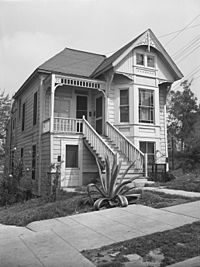
Postwar: Baby Boomers and Growth
After the war, many land developers bought cheap land, divided it, built houses, and became rich. Real estate development became the main industry in Southern California. In 1955, Walt Disney opened the world's first theme park, Disneyland, in Anaheim. In 1958, Major League Baseball teams, the Dodgers and Giants, moved to Los Angeles and San Francisco. California's population grew greatly, reaching almost 20 million by 1970. This was the time when the baby boom generation grew up. By 1950, Los Angeles was a huge industrial and financial city. It built more cars than any city except Detroit. It made more tires than any city but Akron. It also made more furniture and clothes than many other cities. It was the national center for making movies, radio programs, and soon, television shows. Construction boomed as new houses were built in growing suburban areas. Popular music of the time often talked about California's promise of easy living in a beautiful climate. The surfing culture also grew.
Los Angeles continued to spread out, especially with the growth of the San Fernando Valley and the building of freeways starting in the 1940s. When the local streetcar system closed, Los Angeles became a city built around cars. This created social, health, and political problems. The famous urban sprawl of Los Angeles became a key feature of the city. The pace of growth sped up in the early 1900s. The San Fernando Valley became a favorite place for developers. The city started growing beyond its downtown roots toward the ocean and the east. The huge problem with air pollution (smog) that developed by the early 1970s also caused a reaction. Schools were often closed for "smog days" when air quality was unhealthy. The hills around urban areas were often not visible. Californians wanted changes. Over the next three decades, California passed some of the strictest anti-smog rules in the U.S. It has been a leader in encouraging cleaner ways for industries, including cars. For example, carpool lanes usually require two or more people, but electric cars can use them with only one person. As a result, smog is much less than it used to be.
Los Angeles: 1950–2000
Starting November 6, 1961, Los Angeles had three days of destructive bush fires. The Bel-Air—Brentwood and Santa Ynez fires destroyed 484 expensive homes and 21 other buildings. They also burned 15,810 acres of brush in the Bel-Air, Brentwood, and Topanga Canyon areas. Most of the destroyed homes had wooden roofs, which helped the fire spread. Despite this, few changes were made to building rules to prevent future losses.
A law limiting building height was removed. The redevelopment of Bunker Hill, which changed a unique but old neighborhood, led to the building of new skyscrapers. Bunker Hill's 62-floor First Interstate Building was the tallest in Los Angeles when it was finished in 1973. It was later surpassed by the Library Tower (now the U.S. Bank Tower) in 1990. This 1,018-foot building is the tallest west of the Mississippi River. Outside of Downtown, the Wilshire Corridor has many tall buildings. Century City, built on the former 20th Century Fox studio lot, has also become a center for high-rise buildings.
A subway system was developed in the 1980s. This was a major goal of mayor Tom Bradley. It stretches from North Hollywood to Union Station and connects to light rail lines that go to nearby cities like Long Beach and Pasadena. Also, a commuter rail system, Metrolink, was added. It connects Los Angeles to places like Ventura and San Bernardino. The funding for this project comes from a half-cent tax increase. Although the transit system is growing, subway expansion was stopped in the 1990s due to concerns about methane gas, political issues, and construction problems. As a result, light rail systems and bus routes have become the main ways to travel in Los Angeles's busy areas.
Fair Housing and Civil Rights
Since its beginning, the city was divided by different ethnic groups. In the 1920s, Los Angeles had the first rules that limited where people could live based on their race. By World War II, 95 percent of Los Angeles housing was off-limits to Black and Asian people. Minorities who served in World War II or worked in L.A.'s defense industries returned to face more discrimination in housing. They were increasingly kept out of the suburbs and limited to housing in East or South Los Angeles, Watts, and Compton. These housing practices severely limited their chances for education and jobs.
In 1955, William Byron Rumford, the first African-American from Northern California in the state legislature, introduced a fair-housing bill. In 1959, the California Legislature passed the California Fair Employment Practices Act. That same year, the state's Unruh Civil Rights Act addressed fair housing but did not have strong enforcement.
In 1963, the California Legislature passed the Rumford Fair Housing Act. This law made it illegal to refuse to rent or sell housing based on race, ethnicity, gender, marital status, or physical disability.
In response to the Rumford Act, a group of realtors and landlords started a campaign. They wanted a referendum to change the state Constitution. This change would protect property owners' right to deny minorities equal access to housing. This was known as Proposition 14, and it caused a lot of strong debate across the state.
While some conservatives argued that Black people were "better off in Los Angeles than anywhere else," Black people knew they were kept from sharing in the city's success. On May 26, 1963, Dr. Martin Luther King, Jr. told a crowd of 35,000 people, "We want to be free whether we're in Birmingham or in Los Angeles."
In November 1964, California voters passed Proposition 14 by a large margin.
In August 1965, the Watts Riots broke out. They lasted six days. 32 people died, 1,032 were injured, and 3,952 were arrested. There was $40 million in damage, and 1,000 buildings were damaged or destroyed. Later reports said the riot was a reaction to a long history of police unfairness and other injustices suffered by Black people, including discrimination in jobs, housing, and education.
In 1966, the California State Supreme Court ruled that Proposition 14 violated the State Constitution's rules for equal protection.
In 1967, the U.S. Supreme Court confirmed this decision. It ruled that Proposition 14 had violated the 14th Amendment of the United States Constitution. The federal Civil Rights Act of 1964 also addressed this issue.
In 1973, Los Angeles became the first major Western city to elect a Black mayor, Tom Bradley.
Economic and Population Changes
The last car factories closed in the 1990s. Tire factories and steel mills left earlier. Most farms and dairy operations moved to other counties. The furniture industry moved to Mexico and other countries with lower wages. Airplane production has dropped since the end of the Cold War. Movie producers sometimes find cheaper places to make films. However, the film, television, and music industries are still based in Los Angeles. Many studios still operate there, like CBS Television City and 20th Century Fox. The clothing industry grew large in the early 1900s, focusing on sportswear. By 1945, it was the second largest in the U.S.
Toyota opened its first overseas office in Hollywood in 1957. It sold 257 cars in the U.S. It moved operations to Torrance in 1982 for easier access to ports and LAX airport. In 2013, it sold 2.2 million vehicles in the U.S. In 2014, it announced it would move 3,000 employees to Texas to be closer to its American factories.
The ports of Los Angeles and Long Beach form the nation's largest harbor complex. They handle 44% of all goods imported by cargo container into the United States. In 2007, the equivalent of 7.85 million 40-foot shipping containers passed through the ports. Most then moved along the region's highways to warehouses before going to other parts of the country. International trade has created hundreds of thousands of jobs in Southern California. Moving goods is now one of the region's largest industries. It helps provide low-cost imports to consumers across the country. The ports are among the region's most valuable economic engines.
The overall economy of metropolitan Los Angeles was healthy. In one five-year period (1985 to 1990), it attracted 400,000 working immigrants (mostly from Asia and Mexico). It also attracted about 575,000 workers from other parts of the U.S. The jobs they were offered depended on their education. Large economic changes have brought major social changes. While unemployment dropped in Los Angeles in the 1990s, the new jobs tended to be low-wage jobs filled by recent immigrants. The number of poor families increased during this time. At the same time, the number of immigrants from Mexico, Central America, and Latin America has made Los Angeles a "majority minority" city. It will soon be mostly Latino.
The desire for homes in the downtown area has led to gentrification. Old commercial buildings have been renovated into condos. Many new apartment and condominium towers are being built.
Since the 1980s, there has been a growing gap between the rich and the poor. This makes Los Angeles one of the most socially divided cities in the United States.
By the end of the 20th century, some annexed areas felt cut off from the city's political process. This led to a strong movement for the San Fernando Valley to separate from the city. Smaller movements also existed in San Pedro and Hollywood. Voters rejected these proposals to split the city in November 2002.
Many communities in Los Angeles have changed their ethnic makeup during this time. For many decades, the population was mostly white and American-born. South L.A. was mostly white until the 1950s. Then it became mostly Black until the 1990s. Now it is mainly Latino. The Latino community, once centered in East Los Angeles, now extends throughout the city. The San Fernando Valley, which was a place for white families to move in the 1960s, is now as diverse as the rest of the city.
Population History
The population of Los Angeles reached over 100,000 by the 1900 census. It reached over a million in 1930, over two million in 1960, and over 3 million in 1990.
| Year | Population | Growth |
|---|---|---|
| 1790 | 131 | — |
| 1800 | 315 | 184 |
| 1810 | 365 | 50 |
| 1820 | 650 | 285 |
| 1830 | 1,300 | 650 |
| 1840 | 2,240 | 940 |
| 1850 | — | — |
| 1860 | 4,385 | — |
| 1870 | 5,730 | 1,345 |
| 1880 | 11,200 | 5,470 |
| 1890 | 50,400 | 39,200 |
| 1900 | 102,500 | 52,100 |
| 1910 | 319,200 | 216,700 |
| 1920 | 576,700 | 257,500 |
| 1930 | 1,238,048 | 661,348 |
| 1940 | 1,504,277 | 266,229 |
| 1950 | 1,970,358 | 466,081 |
| 1960 | 2,479,015 | 508,657 |
| 1970 | 2,816,061 | 337,046 |
| 1980 | 2,966,850 | 150,789 |
| 1990 | 3,485,398 | 518,548 |
| 2000 | 3,694,820 | 209,422 |
| 2010 | 3,792,621 | 97,801 |
| 2016 | 4,030,904 | 237,983 |
Images for kids
-
Looking north on Spring Street, 1900. The Hollenbeck Hotel is on the southwest corner. The County Courthouse is in the background.
-
Female workers taking a lunch break at the Vega aircraft plant in Burbank, California, August 1943.
-
This house at 201 N. Flower St. was offered for rent at $20 a month in 1896. In 1946, its four apartments brought in $70 monthly. This house no longer stands near the Walt Disney Concert Hall.
See also
 In Spanish: Historia de Los Ángeles para niños
In Spanish: Historia de Los Ángeles para niños


